Students learn in many different ways, and how they learn social studies vocabulary varies depending on the class. Hard concepts like the Irish potato famine, the American Revolution, or the life of an enslaved woman can become approachable in ways that were not always available within a traditional classroom setting, and in ways where context is provided through the delivery. Vocabulary learned in an economics class is completely different from the words and events students would encounter in a class on ancient civilizations. Each word, phrase, or date must be introduced multiple times for the student to retain that knowledge in their long-term memory.
Gone are the days of history teachers standing in the front of the room teaching vocabulary for social studies and students struggling to catch important details. As new historical events occur each and every day, teachers need to adapt and bring in the most current historical information available. By learning economics, civics, ancient civilizations and their history, geography, and modern history, students can see the world around them in a new light. As a teacher, it is daunting to try to make these classes seem approachable for students of all ages and abilities and employ various social studies vocabulary activities to expand their knowledge.
Why is teaching social studies vocabulary important?
Simply put, without an understanding of social studies vocabulary, students would not have a strong foundation for understanding complex primary and secondary sources that are found in the world around them. Think about it! Without ancient scientists who studied the innovation around glass and magnification, Galileo would not have discovered Jupiter’s moons. Music lyrics, the news, and even other subjects in school and their discoveries can be tied back to history classes. Researchers assert that when students read text, their vocabulary development can advance as well. Social studies vocabulary activities that encourage students to read, explore, and analyze various sources allow for language acquisition and appeal to various learning styles. Below is a sampling of activities to help teach social studies vocabulary, broken down into pre-assessment, bell ringers, during a lesson, exit tickets, and summative or end-of-unit assessments, all structured to help students learn more effectively.
Use Flocabulary for vocabulary instruction
Flocabulary was created back in 2004 and has always been focused on vocabulary acquisition for a variety of subjects. Through the videos created by Flocabulary and the six additional activities within the lesson sequence, students can learn and show proof of their knowledge of the vocabulary.
Starting students off with a lesson in geography—where they study the differences between urban, suburban, and rural areas—will help them later in the study of urbanization and industrialization in early 20th-century America. Using Flocabulary regularly within the classroom and learning strategies to teach vocabulary have been proven to raise student scores on standardized tests.
Here is an example of the style of videos you can find on Flocabulary:
A helpful tip is to make sure you filter your searches by standard! You can access that option at any time when you log into your Flocabulary account; next to the magnifying glass, select your state standard, and then select all standards. Those correlations will allow you to target your lessons.


New to Flocabulary? Teachers can sign up for a trial to access our lesson videos and assessment activities. Administrators can get in touch with us to learn more about unlocking the full power of Flocabulary through Flocabulary Plus.
18 Engaging social studies vocabulary activities
Pre-assessments
A great way to study growth within a social studies classroom is by pre-assessing students at the beginning of every unit, and then again at the end of every unit. By taking the “temperature” of the classroom at the beginning and end, you can measure growth and pivot or reinforce strategies. Below are three suggested vocabulary activities for social studies that you can use to complete this task.
1. Rate knowledge of vocabulary words
This is great for students of all ages. By measuring their confidence through rating vocabulary words, you, as the teacher, can see how much time you must devote to each word within a unit. You can give students these rating graphic organizers on paper or digitally. Collect them once they’re initially completed, and then have students revisit them at the end of the unit as well. This measurement in growth also can be a confidence boost for students as they go through the class.
2. Give the 10-question quiz in Flocabulary
Start off by choosing a Flocabulary lesson that relates to the social studies topic you’re teaching. Then, go to the Quiz part of the lesson sequence. By assigning the 10-question quiz found in all Flocabulary assignments, you can get an instant measurement of understanding. Vocabulary analytics are also included with Flocabulary Plus. Teachers and administrators can get further insight into how students learn, and if needed, additional reinforcement can be provided.

3. Poll students
Polls are a great tool within a classroom to get a quick perspective of knowledge before starting a unit. By gathering a social studies vocabulary list and having students rate their confidence with those words, you can get quick insight on how confident they might feel about the upcoming unit. Retest at the end to see their growth and comprehension! Utilize different digital platforms like Nearpod, and Google or Microsoft Forms, to compare and get instant feedback quickly.
4. Bell ringers
Bell ringers are meant to immediately immerse students within the learning of the day or recall a lesson they learned the day before to reactivate that prior knowledge. When constructing bell ringers, it’s best to start students with an engaging and fun activity. Below are four options to immediately immerse your students in the study of vocabulary within a social studies classroom. Try using Flocabulary’s Vocab Game to complete the activity together as a class, or assign it to students separately. Drag the correct vocabulary word to the sentence, and each correct answer will add a new beat. At the end of the activity, students will have built a song!
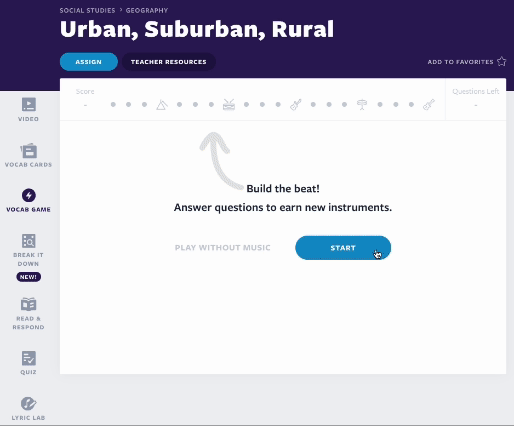
5. Annotate lyrics
Watch a Flocabulary lesson video together as a class and have students annotate the lyrics (which will include the vocabulary words). Provide students with clear instructions on how to annotate. Lyrics can be printed by going into the Teacher Resources. Check this one out on A More Perfect Union! This is a great way to experiment with how to teach social studies vocabulary, as these lyrics can be used in various ways.
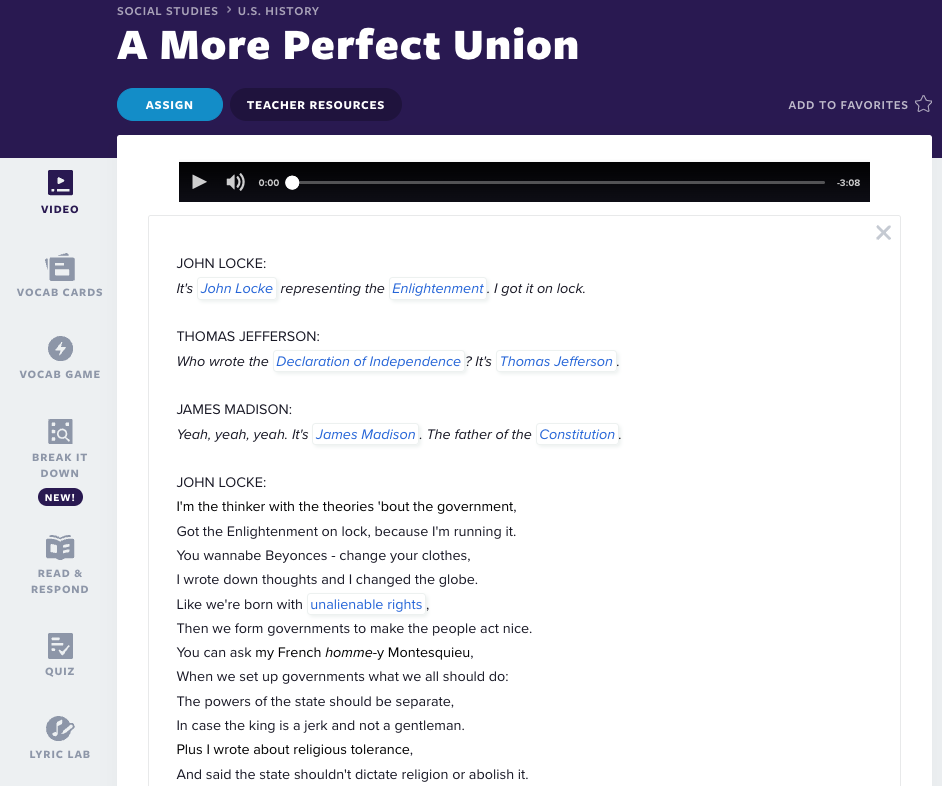
6. Practice with Vocab Cards
Vocab Cards are also a part of Flocabulary’s lesson sequence. Enabling students to show their knowledge through drawing or writing will give them a creative outlet and set the tone for a great class! Don’t forget that our Week in Rap videos also have printable or digital access to Vocab Cards!
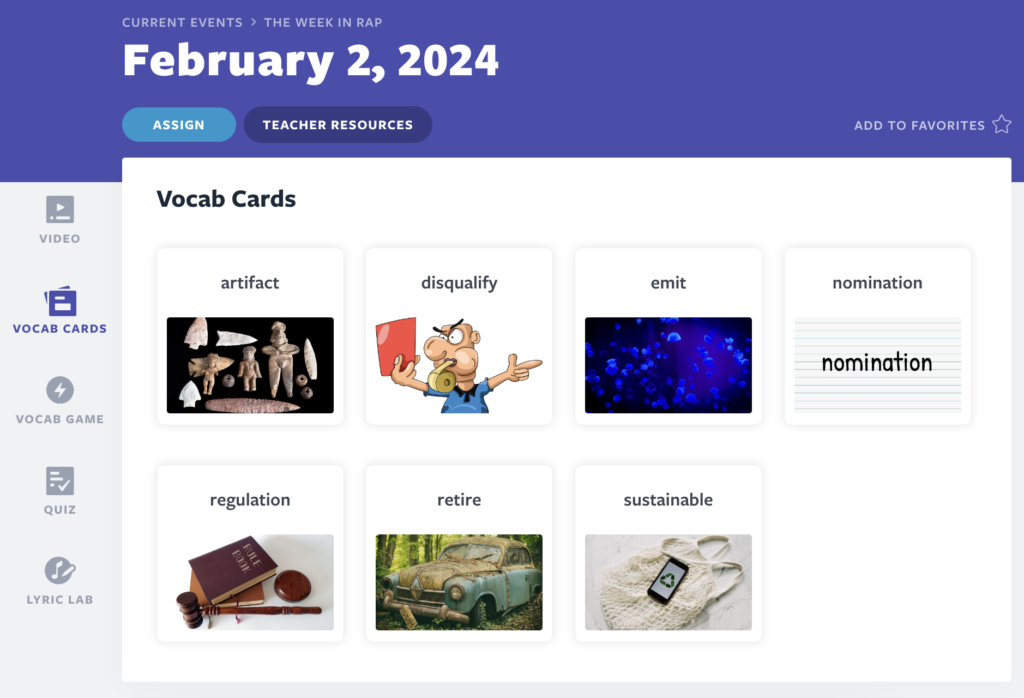
7. “I Have, Who Has?” review game
“I Have, Who Has?“ is a great activity to get students to listen and work together to make connections. It’s a perfect check-in midway to review vocabulary that has been presented so far in the unit. This activity does require some additional prep work, but if you laminate the cards, they can be used for other classes to come! A summary of the game is that each student receives a card with a prompt and a response. The first student will say, “I have…” and then ask who has the definition/date/person in question. This will go around until all students have been included.
8. A-Z vocabulary challenge
This is perfect after students have completed assigned reading or toward the end of a unit. It’s a great bell ringer that enables students to reflect on their learning, and prep is super easy! Have students write out the letters A to Z on lined paper, and have them input a vocabulary word/event/person relevant to the unit you are studying, filling in as many spots as possible. Only one example per line! Set a time limit to encourage students to work efficiently.
During a lesson
Vocabulary activities during a lesson, when students have the opportunity to show their understanding independently or in small groups, helps them learn from their peers collaboratively. Some activities that can be included are the following.
9. Use graphic organizers
Flocabulary has created some great graphic organizers to help students organize the new social studies vocabulary words they will be introduced to! It’s also sometimes included within a lesson under Teacher Resources. For more advanced graphic organizers, create your own, and have students describe/explain the impacts of the events or vocabulary addressed. For AP history teachers, check out the Adamson Adventure! They have amazing study guides that students can add to during a unit. Modify these ideas for your class and students as needed!

10. Break It Down with Flocabulary
Have students complete the Vocab Game and Break It Down activities within Flocabulary. After watching one of the engaging Flocabulary videos, use the activities in the lesson sequence to revisit vocabulary for any social studies class. Flocabulary’s Vocab Game has students match words to their definitions, along with synonyms and image association. Break It Down is an incredible activity that checks for understanding and then requires students to use both video and written evidence to prove their responses. Give it a try by using this lesson on the Age of Exploration!

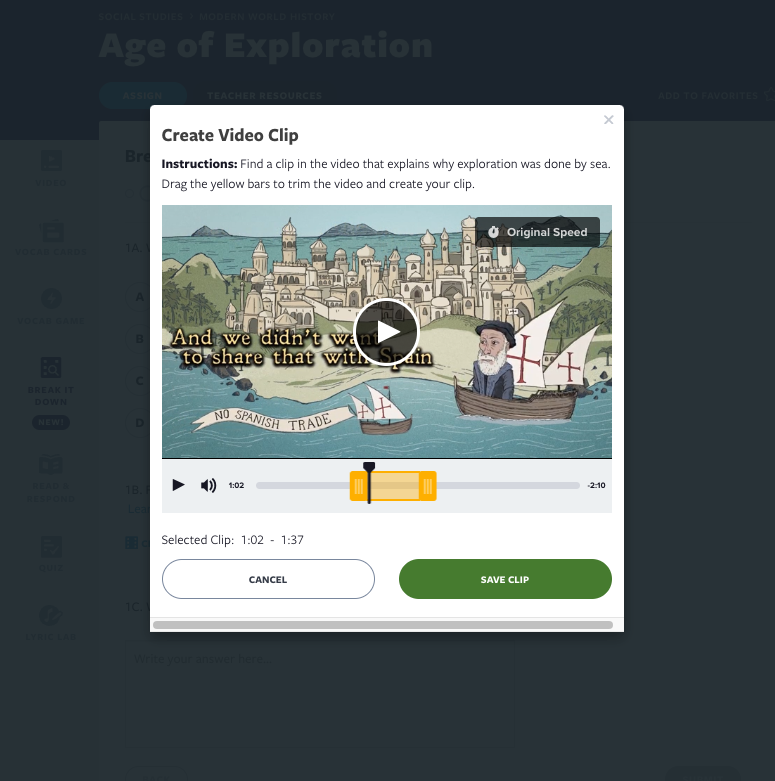
Teachers always look for classroom decorations. Why not enable students to learn vocabulary while also flexing their creativity in the classroom? One-pagers are great for any age and are focused on a centralized idea/event/theme. You can make the requirements as loose or targeted as you’d like. I would highly recommend setting up a rubric to go along with the assignment to give students some additional structure.
12. Hexagonal thinking
A great way for students to both work together and learn more about vocabulary in social studies, and how events and people connect, is through hexagonal thinking. Students in small groups will make a physical “map” of the connections between historical figures and the events they are associated with. Gamification can be introduced by rewarding students for the most relevant connections. This, once again, does take prep time to create, but these examples can be used for years to come. Alternatively, you can laminate hexagons, and students can add their own examples with dry-erase markers!
Exit tickets
At the end of the lesson, you should complete a quick assessment to see what students have learned and whether information needs to be retaught to them in small groups or the following day. Completing some of the following activities is an easy and quick way to assess what and how much they’ve learned.
13. Semantic mapping
Students can easily complete semantic mapping at the end of a lesson. Provide students with a list of words, and have them sort the vocabulary into categories. The number of words and categories is up to you as the teacher, but this is a great differentiated activity. Some examples of categories include: People, Industry, Government, Religion, and Places.
14. Roll the dice
Complete a “roll the dice” activity. Teachers start by preparing a list of vocabulary words and then divide students into small groups or pairs. Have students roll dice to do a variety of tasks. These could include writing the word in a sentence, creating a definition, and giving the word historical context. There are many ways that you can flex the instructions to suit your students’ needs.
15. Complete a Read and Respond
The Flocabulary lesson sequence enables you as the teacher to assess in various ways. Using the Read and Respond activity, you can assess students’ reading comprehension, and their responses are automatically graded with a Flocabulary Plus subscription. This activity is also a great way to help students learn and practice academic vocabulary. Take a look at this Read and Respond on Katherine Johnson!
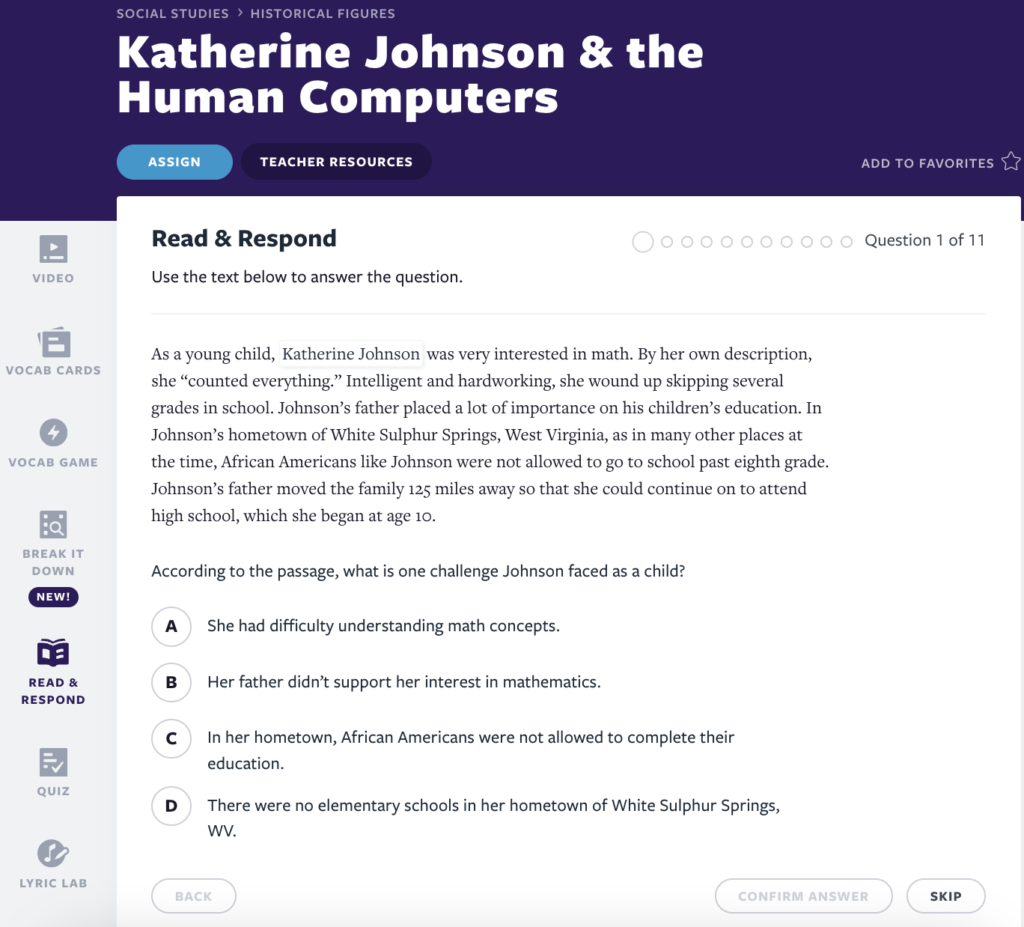
End-of-unit activities
The following activities are summative and can be completed independently or in small groups to demonstrate an understanding of the concepts introduced in the unit.
16. Lyric Lab
In Lyric Lab, students can create a set of lyrics about an assigned topic using the vocabulary words they learned during the Flocabulary video. Have students write their lyrics within Flocabulary, and they will automatically be saved with a Plus subscription. As the teacher, you can craft the prompt, and to make it an end-of-unit activity, have students construct their presentation using a rubric. Lyric Lab includes a vocabulary word bank, a rhyme generator, and beats they can use to make their song. Students can rap it, read it as poetry, or simply marvel at their masterpiece. Have students write a rap about Spartacus and Ancient Rome with this lesson!
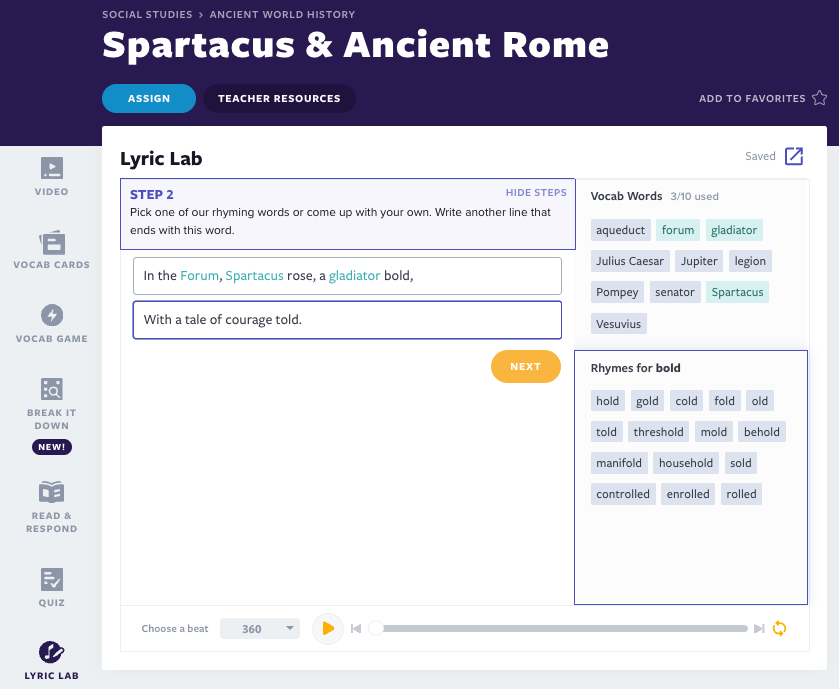
17. Speed dating of historical figures
Speed Dating of Historical Figures works best for high school vocabulary strategies for social studies. Students will not only need to know their assigned “character,” they will also need to know and understand the impact and events these individuals helped bring about. With the limited time to communicate with their “dating partner,” students will have had to thoroughly study their character and be prepared to speak of what they have accomplished. In AP U.S. history, we successfully used this activity to study the Progressive Era. Have students complete a chart with the characters they will interact with. This project can be modified, but students enjoyed the activity and even dressed up to make the assignment more engaging. As the teacher, circulate around the room to hear the conversations, and be sure to watch the timer to make the activity authentic and fun!
18. Choice boards
A favorite among educators for a reason! Choice boards allow students to explore their strengths and finalize vocabulary learning within the social studies classroom. The possibilities are endless when it comes to these assignments. By giving students rubrics for each section to set expectations and giving them a set amount of time to complete the assignment, you will help students strive to achieve! Use some of the ideas in this blog post or create your own choice board for students. Use various activities to help students learn the same terms by leveraging vocabulary repetition as a teaching tool.
Start using Flocabulary for social studies instruction
There are so many ways to teach vocabulary in social studies. By making the activities engaging, creative, and fun, students and teachers will enjoy the process of learning! Students need to understand vocabulary in order to have success within the classroom and later in life. You can build knowledge and confidence in your students by using the different activities above, along with Flocabulary’s videos and lesson sequence.
New to Flocabulary? Teachers can sign up for a trial to access our lesson videos and assessment activities. Administrators can get in touch with us to learn more about unlocking the full power of Flocabulary through Flocabulary Plus.
- SEO Powered Content & PR Distribution. Get Amplified Today.
- PlatoData.Network Vertical Generative Ai. Empower Yourself. Access Here.
- PlatoAiStream. Web3 Intelligence. Knowledge Amplified. Access Here.
- PlatoESG. Carbon, CleanTech, Energy, Environment, Solar, Waste Management. Access Here.
- PlatoHealth. Biotech and Clinical Trials Intelligence. Access Here.
- Source: https://blog.flocabulary.com/social-studies-vocabulary/



